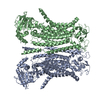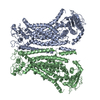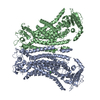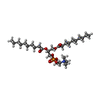[English] 日本語
 Yorodumi
Yorodumi- PDB-8b8k: Cryo-EM structure of Ca2+-bound mTMEM16F N562A mutant in Digitoni... -
+ Open data
Open data
- Basic information
Basic information
| Entry | Database: PDB / ID: 8b8k | ||||||
|---|---|---|---|---|---|---|---|
| Title | Cryo-EM structure of Ca2+-bound mTMEM16F N562A mutant in Digitonin closed/closed | ||||||
 Components Components | Anoctamin-6 Calcium-dependent chloride channel Calcium-dependent chloride channel | ||||||
 Keywords Keywords |  MEMBRANE PROTEIN / Lipid Transport / Lipid Scramblase / MEMBRANE PROTEIN / Lipid Transport / Lipid Scramblase /  Ion Channel / Ion Channel /  Blood Coagulation / Blood Coagulation /  Membrane Fusion Membrane Fusion | ||||||
| Function / homology |  Function and homology information Function and homology informationcalcium activated phospholipid scrambling / calcium activated phosphatidylserine scrambling / calcium activated phosphatidylcholine scrambling / calcium activated galactosylceramide scrambling / phosphatidylserine exposure on blood platelet / positive regulation of potassium ion export across plasma membrane / purinergic nucleotide receptor signaling pathway / positive regulation of monoatomic ion transmembrane transport /  phospholipid scramblase activity / activation of blood coagulation via clotting cascade ...calcium activated phospholipid scrambling / calcium activated phosphatidylserine scrambling / calcium activated phosphatidylcholine scrambling / calcium activated galactosylceramide scrambling / phosphatidylserine exposure on blood platelet / positive regulation of potassium ion export across plasma membrane / purinergic nucleotide receptor signaling pathway / positive regulation of monoatomic ion transmembrane transport / phospholipid scramblase activity / activation of blood coagulation via clotting cascade ...calcium activated phospholipid scrambling / calcium activated phosphatidylserine scrambling / calcium activated phosphatidylcholine scrambling / calcium activated galactosylceramide scrambling / phosphatidylserine exposure on blood platelet / positive regulation of potassium ion export across plasma membrane / purinergic nucleotide receptor signaling pathway / positive regulation of monoatomic ion transmembrane transport /  phospholipid scramblase activity / activation of blood coagulation via clotting cascade / negative regulation of cell volume / intracellularly calcium-gated chloride channel activity / bone mineralization involved in bone maturation / pore complex assembly / cholinergic synapse / plasma membrane phospholipid scrambling / bleb assembly / voltage-gated monoatomic ion channel activity / positive regulation of phagocytosis, engulfment / Stimuli-sensing channels / voltage-gated chloride channel activity / calcium-activated cation channel activity / positive regulation of endothelial cell apoptotic process / positive regulation of monocyte chemotaxis / dendritic cell chemotaxis / phospholipid translocation / chloride transport / phospholipid scramblase activity / activation of blood coagulation via clotting cascade / negative regulation of cell volume / intracellularly calcium-gated chloride channel activity / bone mineralization involved in bone maturation / pore complex assembly / cholinergic synapse / plasma membrane phospholipid scrambling / bleb assembly / voltage-gated monoatomic ion channel activity / positive regulation of phagocytosis, engulfment / Stimuli-sensing channels / voltage-gated chloride channel activity / calcium-activated cation channel activity / positive regulation of endothelial cell apoptotic process / positive regulation of monocyte chemotaxis / dendritic cell chemotaxis / phospholipid translocation / chloride transport /  chloride channel activity / chloride channel activity /  chloride channel complex / monoatomic cation transport / sodium ion transmembrane transport / regulation of postsynaptic membrane potential / positive regulation of bone mineralization / chloride transmembrane transport / Neutrophil degranulation / chloride channel complex / monoatomic cation transport / sodium ion transmembrane transport / regulation of postsynaptic membrane potential / positive regulation of bone mineralization / chloride transmembrane transport / Neutrophil degranulation /  synaptic membrane / establishment of localization in cell / calcium ion transmembrane transport / synaptic membrane / establishment of localization in cell / calcium ion transmembrane transport /  blood coagulation / positive regulation of apoptotic process / protein homodimerization activity / identical protein binding / blood coagulation / positive regulation of apoptotic process / protein homodimerization activity / identical protein binding /  metal ion binding / metal ion binding /  plasma membrane / plasma membrane /  cytosol cytosolSimilarity search - Function | ||||||
| Biological species |   Mus musculus (house mouse) Mus musculus (house mouse) | ||||||
| Method |  ELECTRON MICROSCOPY / ELECTRON MICROSCOPY /  single particle reconstruction / single particle reconstruction /  cryo EM / Resolution: 3.01 Å cryo EM / Resolution: 3.01 Å | ||||||
 Authors Authors | Arndt, M. / Alvadia, C. / Straub, M.S. / Clerico-Mosina, V. / Paulino, C. / Dutzler, R. | ||||||
| Funding support | European Union, 1items
| ||||||
 Citation Citation |  Journal: Nat Commun / Year: 2022 Journal: Nat Commun / Year: 2022Title: Structural basis for the activation of the lipid scramblase TMEM16F. Authors: Melanie Arndt / Carolina Alvadia / Monique S Straub / Vanessa Clerico Mosina / Cristina Paulino / Raimund Dutzler /   Abstract: TMEM16F, a member of the conserved TMEM16 family, plays a central role in the initiation of blood coagulation and the fusion of trophoblasts. The protein mediates passive ion and lipid transport in ...TMEM16F, a member of the conserved TMEM16 family, plays a central role in the initiation of blood coagulation and the fusion of trophoblasts. The protein mediates passive ion and lipid transport in response to an increase in intracellular Ca. However, the mechanism of how the protein facilitates both processes has remained elusive. Here we investigate the basis for TMEM16F activation. In a screen of residues lining the proposed site of conduction, we identify mutants with strongly activating phenotype. Structures of these mutants determined herein by cryo-electron microscopy show major rearrangements leading to the exposure of hydrophilic patches to the membrane, whose distortion facilitates lipid diffusion. The concomitant opening of a pore promotes ion conduction in the same protein conformation. Our work has revealed a mechanism that is distinct for this branch of the family and that will aid the development of a specific pharmacology for a promising drug target. | ||||||
| History |
|
- Structure visualization
Structure visualization
| Structure viewer | Molecule:  Molmil Molmil Jmol/JSmol Jmol/JSmol |
|---|
- Downloads & links
Downloads & links
- Download
Download
| PDBx/mmCIF format |  8b8k.cif.gz 8b8k.cif.gz | 313.6 KB | Display |  PDBx/mmCIF format PDBx/mmCIF format |
|---|---|---|---|---|
| PDB format |  pdb8b8k.ent.gz pdb8b8k.ent.gz | 252 KB | Display |  PDB format PDB format |
| PDBx/mmJSON format |  8b8k.json.gz 8b8k.json.gz | Tree view |  PDBx/mmJSON format PDBx/mmJSON format | |
| Others |  Other downloads Other downloads |
-Validation report
| Arichive directory |  https://data.pdbj.org/pub/pdb/validation_reports/b8/8b8k https://data.pdbj.org/pub/pdb/validation_reports/b8/8b8k ftp://data.pdbj.org/pub/pdb/validation_reports/b8/8b8k ftp://data.pdbj.org/pub/pdb/validation_reports/b8/8b8k | HTTPS FTP |
|---|
-Related structure data
| Related structure data |  15916MC  8b8gC  8b8jC  8b8mC  8b8qC  8bc0C  8bc1C M: map data used to model this data C: citing same article ( |
|---|---|
| Similar structure data | Similarity search - Function & homology  F&H Search F&H Search |
- Links
Links
- Assembly
Assembly
| Deposited unit | 
|
|---|---|
| 1 |
|
- Components
Components
| #1: Protein |  Calcium-dependent chloride channel / Small-conductance calcium-activated nonselective cation channel / SCAN channel / Transmembrane protein 16F Calcium-dependent chloride channel / Small-conductance calcium-activated nonselective cation channel / SCAN channel / Transmembrane protein 16FMass: 113420.602 Da / Num. of mol.: 2 / Mutation: N562A Source method: isolated from a genetically manipulated source Source: (gene. exp.)   Mus musculus (house mouse) / Gene: Ano6, Tmem16f / Production host: Mus musculus (house mouse) / Gene: Ano6, Tmem16f / Production host:   Homo sapiens (human) / References: UniProt: Q6P9J9 Homo sapiens (human) / References: UniProt: Q6P9J9#2: Chemical | ChemComp-CA / #3: Chemical | Has ligand of interest | Y | |
|---|
-Experimental details
-Experiment
| Experiment | Method:  ELECTRON MICROSCOPY ELECTRON MICROSCOPY |
|---|---|
| EM experiment | Aggregation state: PARTICLE / 3D reconstruction method:  single particle reconstruction single particle reconstruction |
- Sample preparation
Sample preparation
| Component | Name: mTMEM16F Ca2+-bound / Type: COMPLEX / Entity ID: #1 / Source: RECOMBINANT |
|---|---|
| Source (natural) | Organism:   Mus musculus (house mouse) Mus musculus (house mouse) |
| Source (recombinant) | Organism:   Homo sapiens (human) Homo sapiens (human) |
| Buffer solution | pH: 7.5 / Details: 20mM HEPES 150mM NaCl 2mM EGTA 0.1% Digitonin |
| Specimen | Embedding applied: NO / Shadowing applied: NO / Staining applied : NO / Vitrification applied : NO / Vitrification applied : YES : YES |
| Specimen support | Grid material: GOLD / Grid mesh size: 200 divisions/in. / Grid type: Quantifoil R1.2/1.3 |
Vitrification | Instrument: FEI VITROBOT MARK IV / Cryogen name: ETHANE-PROPANE / Humidity: 100 % / Chamber temperature: 277 K / Details: 2mM free Ca2+ added shortly before freezing. |
- Electron microscopy imaging
Electron microscopy imaging
| Experimental equipment |  Model: Titan Krios / Image courtesy: FEI Company |
|---|---|
| Microscopy | Model: FEI TITAN KRIOS |
| Electron gun | Electron source : :  FIELD EMISSION GUN / Accelerating voltage: 300 kV / Illumination mode: FLOOD BEAM FIELD EMISSION GUN / Accelerating voltage: 300 kV / Illumination mode: FLOOD BEAM |
| Electron lens | Mode: BRIGHT FIELD Bright-field microscopy / Nominal defocus max: 2400 nm / Nominal defocus min: 1000 nm Bright-field microscopy / Nominal defocus max: 2400 nm / Nominal defocus min: 1000 nm |
| Specimen holder | Cryogen: NITROGEN / Specimen holder model: FEI TITAN KRIOS AUTOGRID HOLDER |
| Image recording | Electron dose: 62.4 e/Å2 / Film or detector model: GATAN K3 BIOQUANTUM (6k x 4k) |
- Processing
Processing
| Software | Name: PHENIX / Version: 1.20.1_4487: / Classification: refinement | ||||||||||||||||||||||||
|---|---|---|---|---|---|---|---|---|---|---|---|---|---|---|---|---|---|---|---|---|---|---|---|---|---|
| EM software |
| ||||||||||||||||||||||||
CTF correction | Type: PHASE FLIPPING AND AMPLITUDE CORRECTION | ||||||||||||||||||||||||
| Symmetry | Point symmetry : C2 (2 fold cyclic : C2 (2 fold cyclic ) ) | ||||||||||||||||||||||||
3D reconstruction | Resolution: 3.01 Å / Resolution method: FSC 0.143 CUT-OFF / Num. of particles: 239346 / Symmetry type: POINT | ||||||||||||||||||||||||
| Atomic model building | B value: 97.7 / Space: REAL | ||||||||||||||||||||||||
| Atomic model building | PDB-ID: 6QP6 | ||||||||||||||||||||||||
| Refine LS restraints |
|
 Movie
Movie Controller
Controller








 PDBj
PDBj












